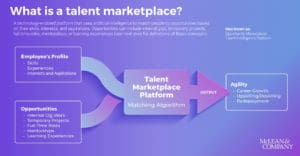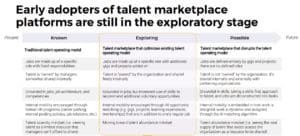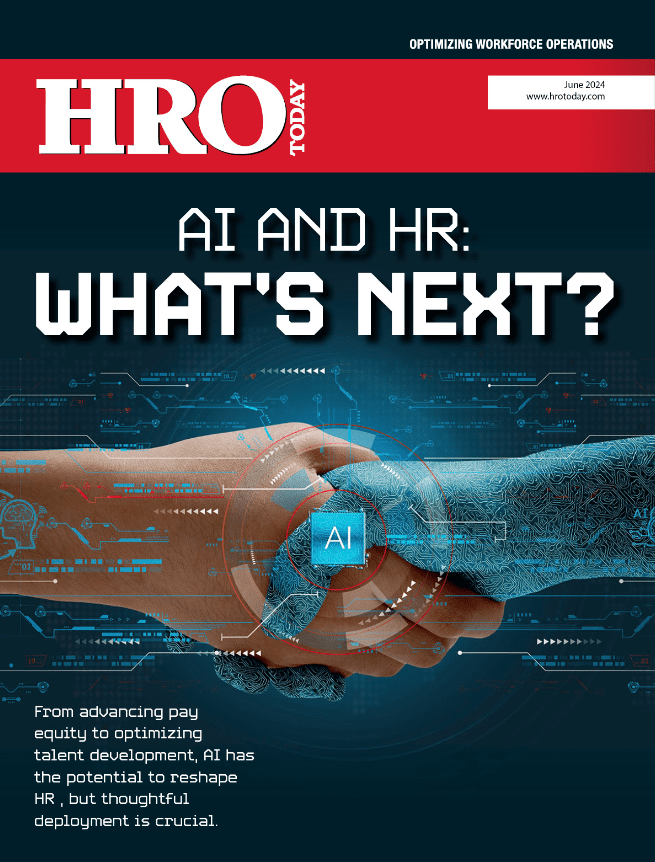Best practices to implementing an approach that empowers employees to drive their own careers – and stay longer.
By Janet Clarey
A whopping 49% percent of employees leave their organization due to lack of opportunities for career advancement. In fact, it’s the number one factor driving turnover, according to McLean & Company’s 2022 Exit Survey. With that in mind, it’s no wonder that recruiting is the top priority for organizations in 2022. HR departments are spending most of their time on talent acquisition activities, increasing efforts by 25% compared to 2021, according to McLean & Company’s HR Trends 2022 research.
And there’s more. As provocative as these numbers are, employees are not only leaving organizations because they’re not advancing in their careers, but because the skills they have are not being put to use or they are not developing new skills for the future. That means three of the top five turnover factors are related to lack of career growth, dissatisfaction with the lack of opportunities to develop new skills, and the inability to apply existing skills. That’s a big deal for organizations and a big opportunity for HR.
Imagine an organization that can empower its employees to find roles, gigs, projects, learning experiences, and mentors based on their skills, interests, and aspirations. An organization like this could more easily match employees to opportunities, leaving talent with fewer reasons to leave. Upskilling and reskilling would be more efficient, and HR would gain efficiencies by freeing up time currently spent on talent acquisition activities. Instead, HR could spend more time tapping into existing internal talent to recruit for open roles.
So, how is this possible? Through an internal talent marketplace, a technology-enabled platform that uses artificial intelligence (AI) to match people to opportunities based on their skills, interests, and aspirations.

AI-enabled matching is a core capability of this approach, providing the potential to fundamentally change how organizations grow and move talent to simultaneously meet employee needs and strategic priorities. An internal talent marketplace marks a new era for the talent operating mode – a creative reimagination of how employees are managed and how work is assigned. However, this potential is only unlocked by a purposeful approach that puts people, mindsets, and culture before technology. This strategy includes understanding the following.
- Design considerations: key decision points that organizations need to make when designing an internal talent marketplace to fit their purpose and meet their needs.
- Technology enablement: common platform types, operational and resource considerations, and risks associated with AI-enabled technology.
- Change management: change and communication required to support the implementation and sustainment of an internal talent marketplace.
Design Considerations
In terms of design considerations, a clearly defined purpose is needed. There are many reasons organizations pursue an internal talent marketplace. Some are looking to solve immediate problems; others are driven by overarching strategic plans to future-proof the organization; and many more seek a combination of the two. Regardless of the reason, it’s critical to clearly define the purpose and link it back to organizational priorities, HR strategy, and/or DEI strategy. The purpose informs the scope, and the scope informs vendor selection, evolutions of HR and non-HR programs, as well as change management. Organizations will also want to measure success by adoption, engagement, and impact.
When planning, it’s important to determine why the organization is pursuing this, what it wants to accomplish, what priorities an internal talent marketplace will support, what success will look like, and what the organization will be able to achieve if the implementation is successful.
Technology Enablement
In terms of technology enablement, it is important to understand common platform types, operational and resource considerations, and risks associated with AI-enabled technology. Platforms can be standalone (pure play/single purpose) tools designed as a specific solution for the talent marketplace, integrated using the modular capability of an organization’s existing HR technology solutions. They can also be augmented—meaning the platform grew from a separate specialized platform, such as learning and recruiting. No matter the platform type, a talent marketplace is resource intensive in terms of people, time, and investment, including maintenance.
The AI within a talent marketplace platform should not replace human involvement. The technology still requires effort from stakeholders well beyond implementation to maintain the human focus and provide a great employee experience. The talent marketplace doesn’t exist in isolation; it requires inputs and connections to current HR systems and other data. System integrations ensure a cohesive experience as well as a skills taxonomy or ontology to provide a single source of all the skills used to populate and match employee profiles and opportunities on the platform.
Advanced data and analytic capabilities—enabled by AI—help organizations do the heavy lifting in understanding things like projected skills gaps to inform strategic workforce planning. That said, using AI and machine learning algorithms comes with risks around bias, including biased data, biased people, biased requirements, and legal concerns. Machine learning is only as good as the historical data it is trained with. Without sufficient oversight and interventions, AI will continue to reflect past biases and amplify their impacts, further exacerbating existing problems with inequitable distribution of opportunities.
Change Management
Perhaps the most important factor when implementing an internal talent marketplace is change management. The first step is having managers and leaders adopt a shared mindset, shifting from a talent scarcity mindset (the belief that talent resources are scarce and in short supply) to a talent abundance mindset (the belief that talent sources are in large supply). Second, a growth strategy and career ownership by employees is required for an active, lively talent marketplace. Communication, employee experience, and implications for HR and managers will be critical areas to address.
The talent marketplace will alter certain HR and managerial responsibilities, but it won’t replace their jobs. Communicating the positive aspects of these responsibility changes improves buy-in and support to ensure a positive experience for HR and managers. Process changes and guidelines are also required to support the substantial shift.
The talent marketplace is ever-evolving. While still relatively new, organizations are continuing to iterate and improve the platform as they look toward the future.
Janet Clarey is a director for McLean & Company.















